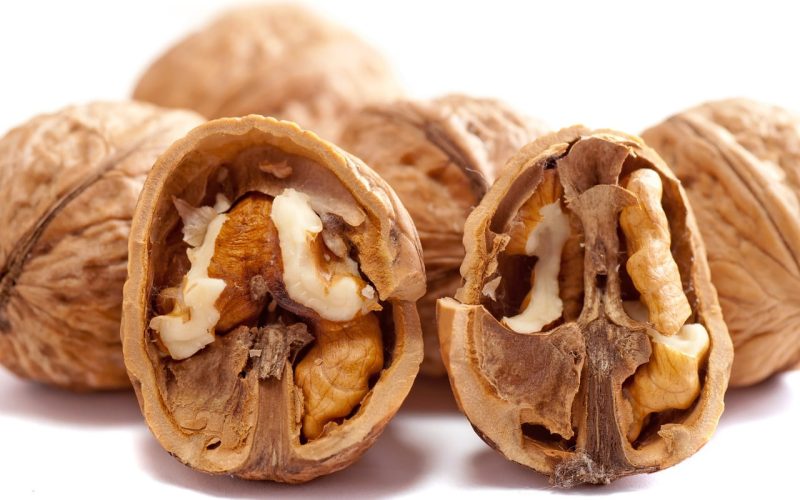Some foods are brown because of how they were cooked, while others are brown due to their inherent coloring.
If they have undergone caramelization, some of the goods in your favorite color may now be brown.
Food turns colored when it caramelizes, which occurs when sugar is present.
For instance, the caramelization process turns the sugar in potatoes and onions brown.
Melanin and other naturally occurring pigments like carotenoids are the other cause of food browning.
For instance, carrots naturally contain a pigment that turns them orange when exposed to light for an extended period.
Here are some of the brown foods.
1. Almonds
An extremely heart-healthy nut is almonds. They are abundant in fiber, vitamin E, monounsaturated fats, and essential minerals like calcium, magnesium, and phosphorus.
Almonds, like most nuts, are heavy in calories and carbs. Just one ounce of almonds provides eighteen percent of your daily protein requirements.
Despite having a high calorific value, they have been associated with a lower risk of becoming obese.
This is primarily because of the protein and fiber they contain, which help regulate blood sugar and fulfill the appetite, so consuming some of these nuts may help you feel less hungry.
According to recent studies, eating almonds regularly can enhance intestinal health and lower the risk of heart disease.
2. Brown Mushroom
Because there are so many different methods to incorporate mushrooms into your diet, they make one of the excellent brown foods. They can be used as toppings for sandwiches, pizza, or sauce. They are a very nutritious type of food.
This kind of mushroom is minimal in calories, fat-free, and cholesterol-free. The most well-known types include shiitake, morel, and porcini mushrooms.
Furthermore, Brown mushrooms, one of the brown foods, are rich in antioxidants, much like all other brown foods. This aids in the body’s defense against free radicals. Also, it strengthens the immune system.
Brown mushrooms are a rich source of vitamins, including B. They are among the greatest brown foods since they directly affect the digestive system and red blood cells.
3. Brown Rice
This brown cuisine differs from its non-brown counterpart in that it is made of entire grains, including the husk. Also, it takes longer to cook than regular rice, which will be apparent to those who consume it.
This is a result of its lack of processing. It is significantly more nutrient-dense and abundant in calcium, fiber, minerals, and vitamins.
It lowers cholesterol and prevents obesity, among other health advantages. Also, because of its low glycemic index, it is excellent for people with diabetes.
This is one of the healthiest brown foods available because of its nutritional advantages and low-calorie count.
4. Baked Beans
Baked beans are traditional favorites, particularly in the UK and North America. Beans, as we all know, have been cooked in a sauce known as baked beans. Tomatoes, molasses, sugar, and spices are used to make the sauce.
The beans that give baked beans their distinctive flavor are American natives and were first grown here. Baked beans are a dark, subdued ginger brown with a persimmon undertone.
Baked beans are excellent sources of protein, fiber, salt, potassium, vitamins C, K, D, E, and thiamin. They are one of the best brown foods.
5. Brown Sugar
Brown sugar is made from sugar cane or sugar beets. The same refining procedure is used to remove moisture and minerals from both white and brown sugar.
Molasses, a byproduct of refined sugar, is added back into brown sugar products, giving them more nutrition. Brown sugar has fewer calories and a distinct flavor than white sugar.
Furthermore, brown sugar contains Iron and potassium, which are crucial for a healthy body and nervous system. Like white sugar, it also contains calcium, which is crucial for the health of our bones and gives us a quick boost of energy.
6. Chestnuts
The fruit of the deciduous chestnut tree, primarily found in the Northern Hemisphere, is the chestnut. It should not be mistaken for the water chestnut or the so-called horse chestnut, both yield fruit that resembles it.
The seed of the chestnut, not the fruit, makes it a chestnut. Chestnut fruits are easily identified by their shape—a kind of globe or dome covered in thorns with a faint sheen.
Furthermore, there are two or three achenes, or chestnuts, inside. Their size can range from two to four centimeters, and they have an endocarp, a hard shell with a convex or convex-plane base. Ripe chestnuts are a dark brown color.
They are a fantastic source of healthy carbohydrates and filling, high in fiber and low in sugar. Thus, they are unique, healthful, and energizing foods.
They also Contain a tiny quantity of group B and C vitamins and are rich in minerals like calcium, magnesium, phosphorus, and potassium. Additionally, they have antioxidant qualities.
Moreover, Chestnuts are the ideal meal to add critical nutrients to your diet because of these qualities. They are a helpful addition to diets for weight loss or maintenance. They make a convenient and nutritious snack in between meals.
7. Brown Bread
Brown bread is prepared mainly from whole grains, usually wheat, and sporadically from dark-hued ingredients such as molasses or coffee.
It supposedly started at the end of the 19th century. Before 1848, brown bread was first documented as consumed during the Famine in Ireland.
Furthermore, brown bread is abundant in Vitamins B, K, and A and contains essential minerals like magnesium, calcium, phosphorus, zinc, and iron. The first loaf of bread was prepared thirty thousand years ago.
8. Chickpeas
Chickpeas are abundant in veggie protein and soluble fiber. A one-ounce portion has only 34 calories and is low in fat and protein, with 75% carbohydrates and 16% protein.
Chickpeas, one of the brown foods, offer a gradual release of energy like other legumes with complex carbs.
This is crucial for those who have diabetes or prediabetes since it enables proper use and glucose regulation.
Simple carbs, such as those in fast food, digest too quickly, quickly spike blood sugar, and make us feel hungry shortly after eating. On the other hand, Chickpeas fill you up and keep your energy levels steady and prolonged.
This is one of the best brown foods. Chickpeas and other legumes provide fiber, which helps decrease cholesterol and promote a healthy digestive system.
According to research, people who frequently eat beans have a fourfold lower risk of developing high blood pressure than those who don’t.
9. Chocolate
Brownish food is milk chocolate. Due to the fat and sugar levels, it is not as healthful as dark chocolate.
However, it is still loaded with potent polyphenols, and these flavonoid polyphenols can lower inflammation and even aid in reducing arterial plaque.
Despite having more sugar than dark chocolate, milk chocolate has fewer calories per ounce—152—at only one ounce.
It is impossible to emphasize the advantages of treating yourself to some chocolate for your mental health!
10. Brown Raisin
Grapes dried or dehydrated for about three weeks are known as brown raisins. Grapes have a dark brown color as they dry and become progressively darker.
The first raisins were discovered approximately 2000 BC, maybe in ancient Persia or Egypt, when some grapes were unintentionally left out in the sun to dry.
Brown raisins have a slightly acidic flavor and are plump and chewy. They go well with sweet and savory foods and are a terrific addition to porridge.
Brown raisins contain fiber, vitamins C and K, and minerals like potassium in moderate amounts. They are one of the best brown foods.
11. Cinnamon
Cinnamon is a sweet, brown spice with many health advantages. The warm hue comes from the inner bark. Although this spice is low in minerals and vitamins, it is high in antioxidants, which help prevent and treat various ailments.
Furthermore, studies have shown that cinnamon can lower blood sugar levels after meals by slowing digestion. Additionally, evidence demonstrates that cinnamon can reduce the risk of heart disease and cardiac problems.
12. Dates
Dates derived from the Phoenix palm species are regarded as exotic fruits. They are also sweet, tasty, and nourishing for the body, which is why they are frequently used as an alternative to refined sugar.
You can get more energy, fiber, and protein from this fruit by eating tiny amounts of it and other nutrients and minerals, including magnesium, potassium, iron, zinc, and vitamins K and B.
Additionally, dates contain anti-inflammatory effects that help with ailments like oxidative stress. Medical research has demonstrated that dates include anti-inflammatory and antibacterial effects.
13. Caramel Corn
A caramel sauce-coated popcorn type makes up this gooey and delectable delight.
Corn and caramel have been paired together since at least the 1890s. Two brothers, Frederick and Louis Rueckheim, created caramel popcorn.
Popcorn with caramel typically has a light to golden brown tint. Caramel popcorn has a variety of contrasts, including a thick outside and a light, fluffy, and airy interior.
They have a savory and sweet flavor. They are a good source of salt, potassium, carbohydrates, carotenoids, lutein, and zeaxanthin.
14. Flaxseeds
Flaxseeds have a wide range of nutritious qualities. They complement virtually anything and are lovely as well. Also, they can offer more significant advantages than whole seeds when pulverized because they are easier to digest.
They are packed with antioxidants that lessen the risk of cell oxidation, fiber, vitamins, minerals, protein, and healthy plant fats. They also include a lot of fiber, which aids in maintaining regular bowel motions and preventing constipation.
Furthermore, they contain copper, phosphorus, magnesium, manganese, and B vitamins (B1, B2, and B6). These vitamins and minerals benefit the immune system, neurological system, bone density, blood circulation, and other systems.
Omega-3 and omega-6 are necessary fatty acids the body cannot manufacture on their own and are abundant in flaxseeds.
Flaxseed has higher fatty acids than canola and soybean oil. Fat makes up half of the calories in flaxseed, but this fat is good for you since it raises good cholesterol.
15. Ginger
The healthiest and one of the essential tubers is ginger. Fresh ginger contains a lot of gingerols, an anti-inflammatory compound. Many nations’ traditional medicine uses it extensively.
Its ability to relieve pregnancy-related nausea is another benefit. Additionally, it’s utilized to treat pain, specifically menstrual discomfort. Additionally, it benefits the digestive system.
It is a very adaptable food that can be used in all recipes, including cookies, cakes, infusions, and oil. You may also consume it dried or fresh. This is one of the best brown foods.
16. Coffee Beans
The coffee plant’s seeds, indigenous to Ethiopia, are known as coffee beans. Coffee, one of the most consumed beverages worldwide, is made with them.
Small and flattened in shape, coffee beans are small. When consumed raw, they have a bitter flavor, but after being roasted, they lose some bitterness.
However, when unroasted, coffee beans are green. Roasted beans, however, come in various colors, from light brown to black. Magnesium, potassium, calcium, iron, thiamin, riboflavin, niacin, phosphorus, and zinc are among the minerals found in coffee beans.
17. Cookies
A cookie is a variety of baked goods that are small, flat, and sweet. The Dutch term “koekje,” which means “small cake,” is where the word “cookie” originates.
About a thousand years ago, in Persia, you first baked cookies. The most popular variety of cookies is the chocolate chip variety, which Ruth Graves Wakefield created in 1938.
Chocolate chip cookies are small, round, flat biscuits with chocolate chips. Most are light to dark brown. Cookies contain protein, salt, fiber, and carbohydrates.
18. Fenugreek Seeds
Fenugreek seeds, a common spice used in Indian cuisine, are angular, rough, and yellowish brown. They have a nutty, sweet, slightly bitter flavor.
Fenugreek seed, native to southern Europe and the Mediterranean, has been used since ancient times. Archaeologists claim that you used this spice as early as 4000 BC.
Furthermore, fenugreek seeds contain Vitamins A, B1, B2, C, iron, pantothenate, nicotinic acid, calcium, pyridoxine, manganese, and biotin.
Toasting the seeds before use can also improve their flavor. Fenugreek leaves are tasty and are used in salads, stews, and curries.
19. Lentils
The earthy legume known as lentils has several health advantages. They are rich in protein, iron, zinc, magnesium, and, most significantly, soluble fiber, all of which are healthy nutrients.
Even though lentils have a lot of carbohydrates, their high fiber content is great for your digestive system.
Additionally, lentils offer a significant amount of vegetable protein. By weight, they boast the third-highest protein concentration of any fruit, vegetable, or nut.
One cup of cooked lentils provides about 90% of the daily need for folate, which lowers the risk of heart disease. Consider including beans, heart-healthy brown lentils, and diabetes-fighting brown lentils in your diet.
Lentils are especially beneficial for vegetarians because they are a good source of iron, a mineral lacking in many vegetarian diets. They are also one of the best brown foods.
20. Peanut Butter
While peanuts are high in protein and healthy omega-3 fats, similar to many nuts, did you know they are legumes rather than nuts? Whatever their classification, peanuts have a low glycemic index, which helps them manage insulin and reduce blood sugar.
However, a recent study showed participants who ate peanuts or peanut butter in the morning experienced less afternoon blood sugar.
Magnesium, phosphorus, zinc, and vitamin B6 are just a few of the crucial minerals that peanut butter is naturally rich in.
You should avoid the more processed peanut butter variants, which are high in sodium, sugar, and hazardous preservatives.
Peanut butter contains about 25% of the recommended amount of saturated fat in a two-tablespoon serving.
Also, take advantage of peanut butter’s health benefits, but don’t consume too much. Two small spoonfuls can have more than 185 calories. This is one of the best brown foods.
21. White Coffee
You’ve probably encountered many kinds of white coffee brewed with milk or creamer. There are almost as many different kinds of coffee to savor as baristas offer, from cappuccino to flat white!
White coffee, though, is more complex than just coffee and milk. This phrase describes softly roasting coffee beans to give them a distinctive flavor and seductive brown hue.
The coffee retains more caffeine due to the shorter roasting time, making it the ideal wake-up drink!
Additionally, coffee contains trace levels of the vitamins B1, B3, and B5. You can reduce type 2 diabetes risk by consuming B vitamins.
Studies have also shown that coffee’s antioxidants can improve long-term glycemic management and combat insulin resistance.
22. Whole Wheat Pasta
The two whole foods are rice and pasta; we could not leave the latter off our ranking. Although most people prefer regular pasta, whole wheat pasta is significantly more nutrient-dense because it hasn’t been processed to remove its nutrients.
You can get 45–65% of your daily calories from whole wheat pasta. Like other unprocessed meals, it can aid in weight loss since it is more filling than manufactured (white) pasta.
Whole wheat pasta has a variety of minerals that are good for your health, including selenium, phosphorus, copper, and magnesium.
Furthermore, if you take extra time to make delicious pasta meals, you won’t notice the flavor shift as much, which will help you overcome your resistance to switching from regular pasta. Making the switch to whole-wheat pasta will help you enjoy a healthier diet.
23. Fudge
Fudge is a sweet that is produced using sugar, milk or cream, butter, and flavorings. It has a solid density and a smooth, creamy texture. A chocolate manufacturer from Baltimore, Maryland, released the first fudge recipe in 1886.
However, Emelyn Battersby Hartridge, a student at Vassar College in New York, was the one who first mentioned fudge in a work of writing.
Fudge is a dark, neutral ginger brown with a persimmon undertone. It contains vital minerals like iron, vitamin A, calcium, and potassium. Fudge is one of the best brown foods.
24. Molasses
The process of refining sugarcane results in the production of molasses, a thick, dark brown syrup. It tastes warm, sweet, and somewhat smokey.
You can add molasses to smoothies, sauces, dressings, and baking. Additionally, you can use it to sweeten tea and coffee.
Molasses was first referenced in Indian scriptures in 500 BCE when it is believed to have been used.
Molasses contains calcium, Magnesium, Iron, and potassium. It also contains selenium, manganese, and vitamin B6.
25. Pecan
The eatable seeds of the Carya illinoinensis tree are known as pecans. They resemble walnuts in shape and are smooth, pinkish-brown nuts.
The center of the nut is packed with delicious, buttery, almost fatty meat, while the exterior has a slight bitterness.
Pecans were first made available to Europeans in the 16th century; they are a native of south-central North America. Furthermore, pecans are a great source of essential elements.
In addition to being a good source of copper, manganese, thiamine, and zinc, they are exceptionally high in fiber. Pecans can be used in baking and cooking and consumed as a snack.
26. Rye Cracker
As the name suggests, rye flour is used to make rye crackers, one of the brown foods.
They have a deep brown color. Initially, you used rye flour, salt, and water to make these, often known as Swedish crispbread.
Crispbread has been produced in Sweden and Finland since 500 AD, initially to store bread for the long winter.
Protein and dietary fiber are both abundant in rye crackers. They are also a great source of potassium, calcium, iron, magnesium, selenium, and magnesium.








